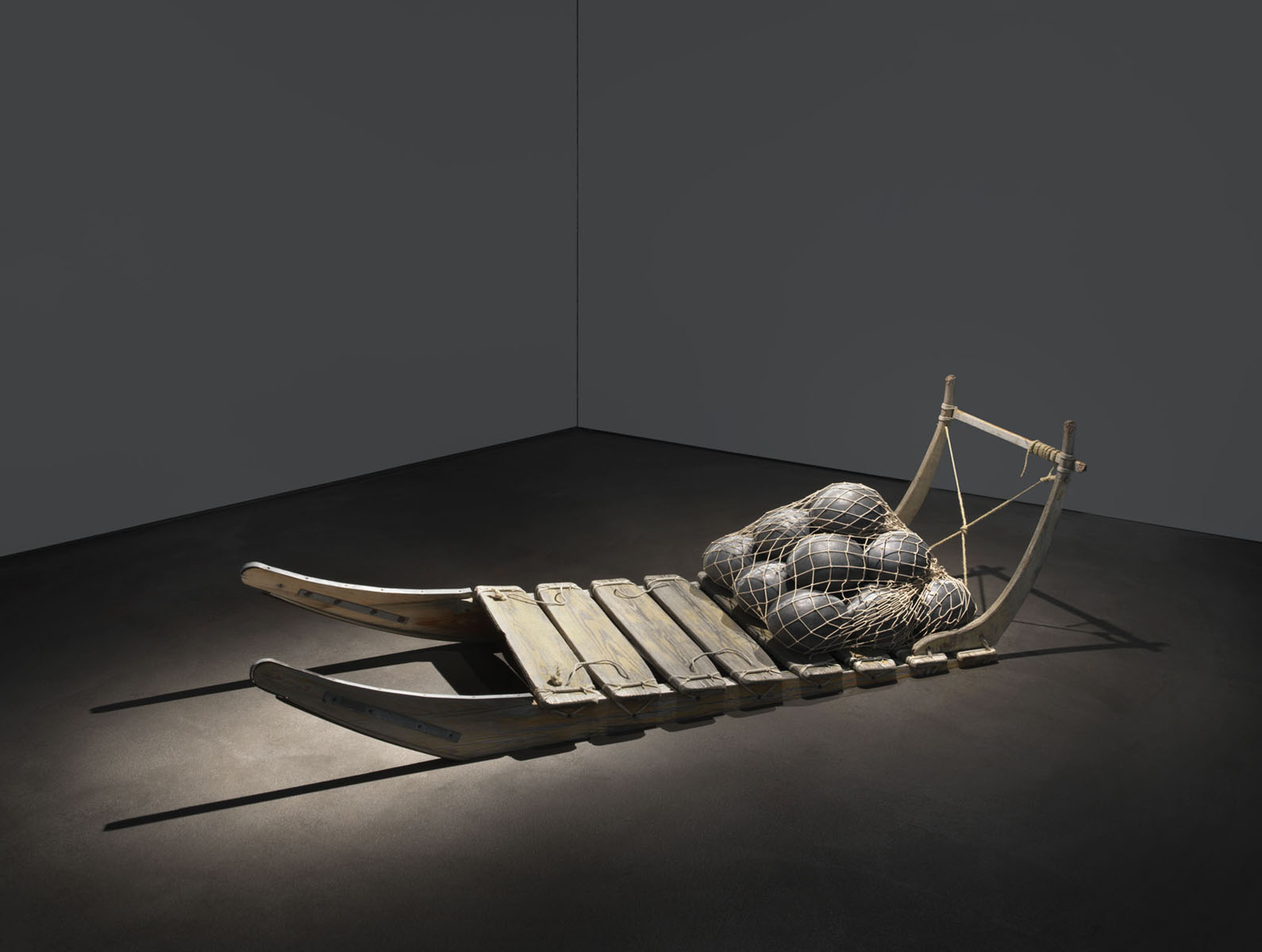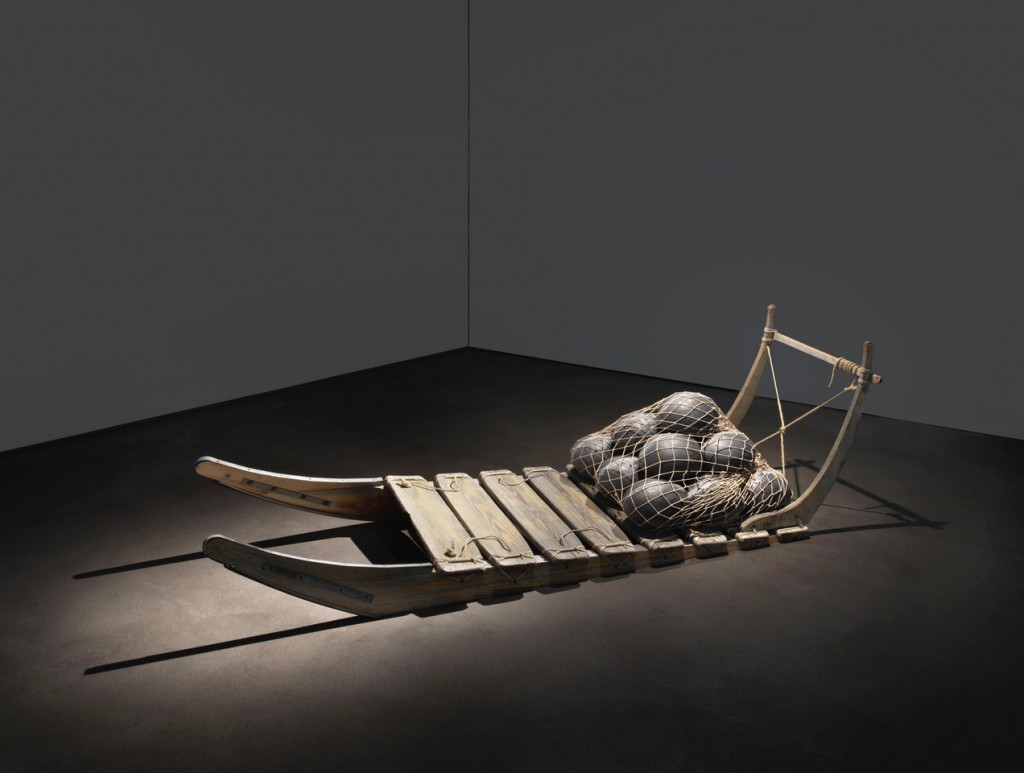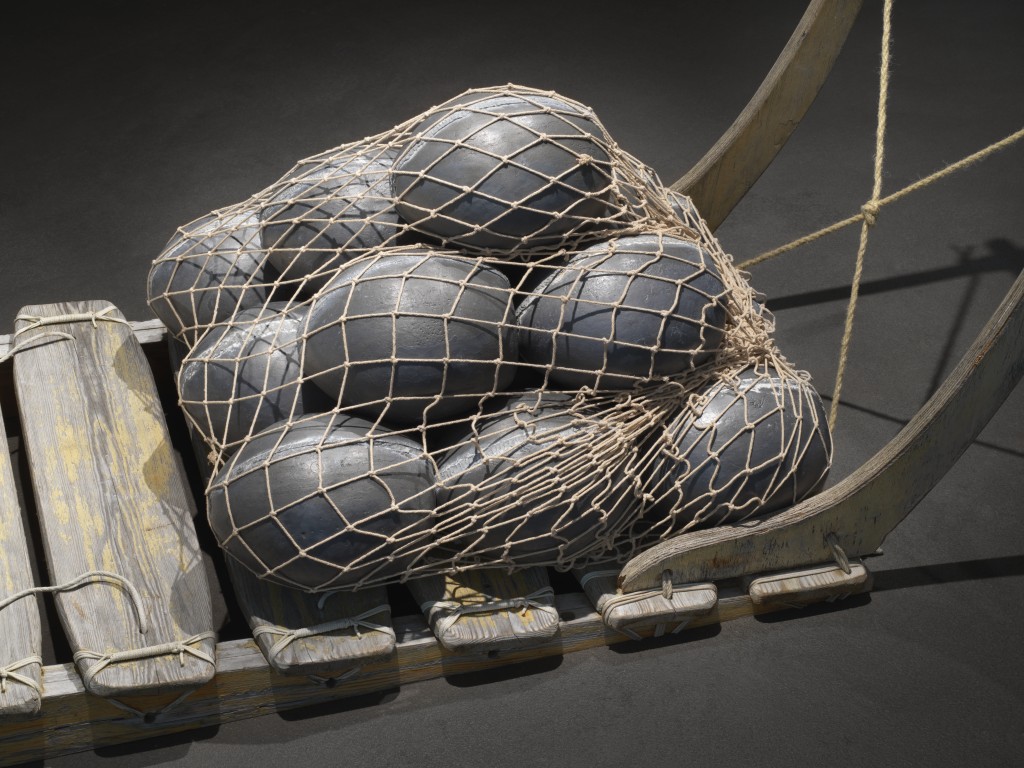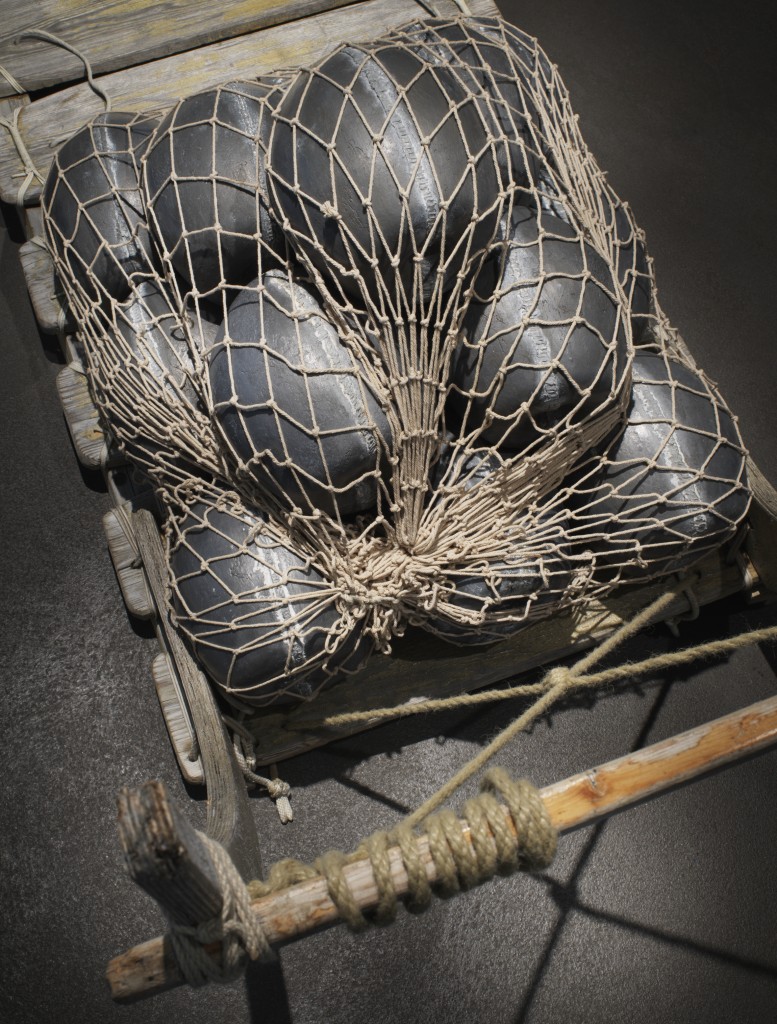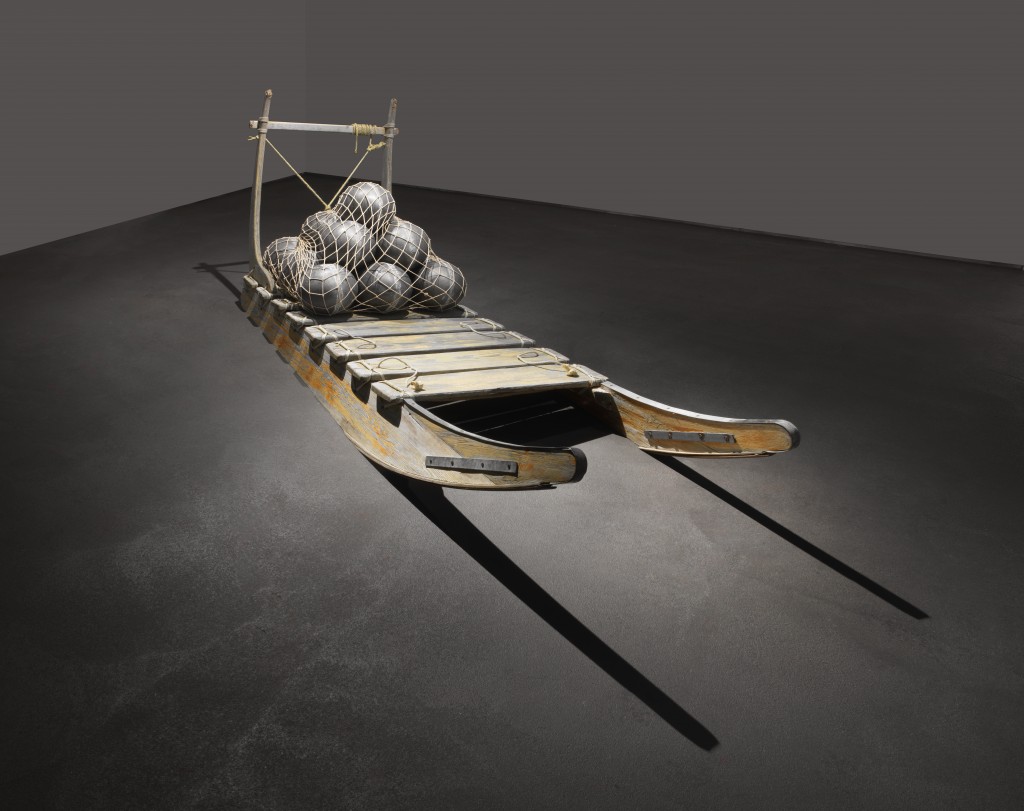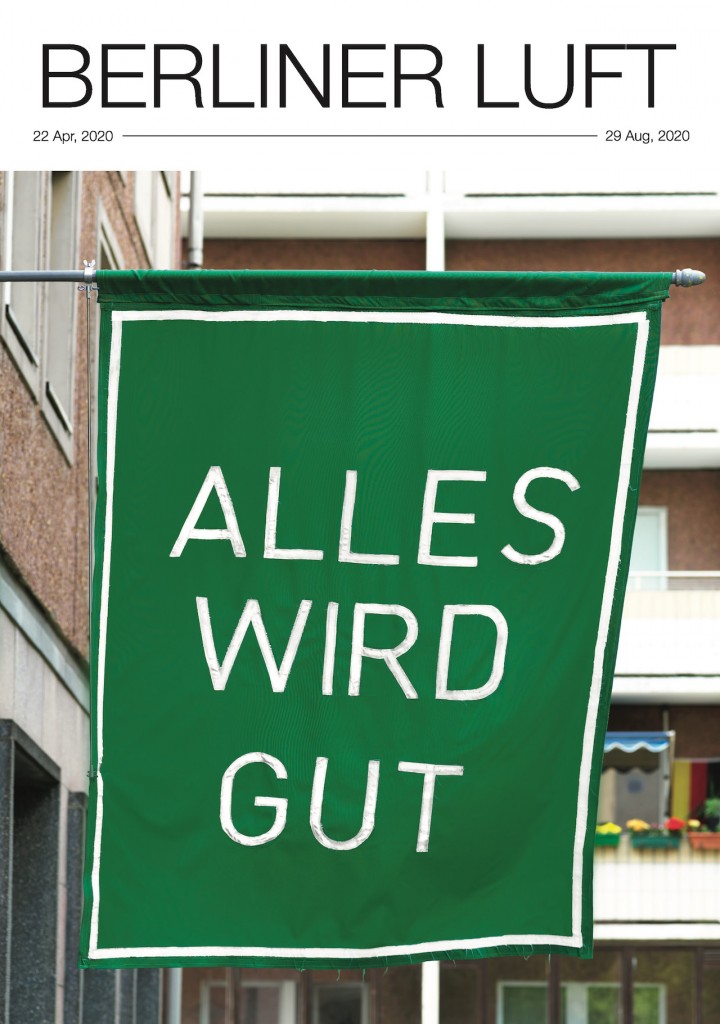Berliner Luft, Julian Charrière
Our third installment of Berliner Luft, on view from Monday, May 11, through Saturday, May 16, features a new sculptural work by Julian Charrière titled Empire (2019). The piece was influenced by his 2019 investigations of the icy landscapes of Greenland for his latest film Towards No Earthly Pole and his 2016 expedition to the nuclear testing grounds of the Marshall Islands for his work on the Pacific Fiction series. Empire, sunk into the concrete floor of the viewing room, confronts issues that pose a menace to humanity, threatening the extermination of civilizations.
In Empire, coconuts that Charrière collected in the Marshall Islands are individually encased in lead. This material coating smothers, suppresses, signifying a colonial imposition, while also “containing” the danger posed by the radiation present within. The contaminated coconuts stand as witnesses to the nuclear weapons tests carried out by the Americans in the 1950s and demonstrate the trauma inflicted on this region by the nuclear project at the dawn of a new era. Stacked as ammunition, the weaponized coconuts evoke the form of an ancient pyramid, with reference to the persistence of culture as well as an architecture of death.
The weighted coconuts now rest on a traditional Inuit sledge that Charrière brought back from Greenland, the climatic opposite to their tropical island origins. In this pairing, the work is conceptually completed. Sinking from its ballast into the melting ice and rising sea level, the work Empire tells of the destructive power of humanity, whose impact extend from the Bikini Atoll to arctic glacial landscapes. The sledge pulled by dogs, a means of transport created by humans themselves, threatens to perish, and with its demise, suggests an extinction or effacement of culture.
Following his solo show at MASI Lugano, Switzerland, Charrière is currently preparing institutional shows to feature an expanded body of works from Towards No Earthly Pole at Aargauer Kunsthaus, Aarau, Switzerland, and the Dallas Museum of Art, Texas, United States, both to open in September 2020.
DITTRICH & SCHLECHTRIEM introduce a new programming series called Berliner Luft, which highlights a different artist each week with a special presentation of art installed in the viewing room of our gallery space at Linienstraße 23 in Berlin-Mitte. The rotating presentations are announced on the gallery’s social media every Sunday evening, and are open for view Monday – Saturday, 11 AM – 6 PM.
Berliner Luft not only reactivates the gallery physically, it also reactivates our relationships with and responsibilities towards art, our artists, and especially the local community in Berlin. This program was developed for you, as we all develop in this new time.
Berliner Luft, Julian Charrière
In der dritten Folge unserer Reihe Berliner Luft zeigen wir von Montag, 11. Mai bis Samstag, 16. Mai eine neue skulpturale Arbeit von Julian Charrière. Inspiriert wurde Empire (2019) von seiner Erkundung des ewigen Eises in Grönland für seinen jüngsten Film, Towards No Earthly Pole, im Jahr 2019 und seine Expedition zu den Nukleartestgeländen der Marshall-Inseln im Zuge der Arbeit an der Reihe Pacific Fiction im Jahr 2016. Die in den Betonboden der Galerie eingesenkte Arbeit nimmt Bedrohungen für die Menschheit in den Blick, die ganze Zivilisationen auslöschen können.
Für Empire hat Charrière Kokosnüsse, die er auf den Marshall-Inseln gesammelt hat, einzeln in Blei eingegossen. Die Schwermetallummantelung erstickt jedes Leben in ihrem Inneren und symbolisiert insofern die drückende Last der Kolonialgeschichte; gleichzeitig „versiegelt“ sie die von der Strahlung in den Kokosnüssen ausgehende Gefahr. Die kontaminierten Kokosnüsse zeugen von den amerikanischen Atomwaffentests der 1950er Jahre und damit von den traumatischen Schäden, die das nukleare Projekt der Region in den Anfangsjahren eines neuen Zeitalters zugefügt hat. Aufgeschichtet wie Munition lassen die „waffenfähigen“ Nüsse an eine antike Pyramide denken und verweisen so auf die Beständigkeit von Kultur, aber auch auf eine Architektur des Todes.
Die beschwerten Kokosnüsse ruhen nun auf einem traditionellen Inuit-Schlitten, den Charrière aus Grönland, dem klimatischen Gegenpol zu ihren Wurzeln auf einer tropischen Inselgruppe, mitgebracht hat. In dieser Kombination schließt sich der konzeptuelle Kreis der Arbeit. Das unter seiner Last in das schmelzende Eis und das ansteigende Wasser der Ozeane einsinkende Empire erzählt von den zerstörerischen Auswirkungen menschlichen Handelns, vom Bikini-Atoll bis zu den Gletscherlandschaften der Arktis. Der von Hunden gezogene Schlitten, ein von Menschen geschaffenes Beförderungsmittel, droht auszusterben; sein Niedergang spiegelt den nahen Tod einer Kultur, die schon bald verschwunden sein könnte.
Nach seiner Einzelausstellung im MASI Lugano (Schweiz) bereitet Charrière derzeit museale Ausstellungen einer erweiterten Werkgruppe rund um Towards No Earthly Pole vor, die ab September 2020 im Aargauer Kunsthaus in Aarau (Schweiz) und im Dallas Museum of Art in Texas (USA) zu sehen sein werden.
DITTRICH & SCHLECHTRIEM stellt eine neue Ausstellungsreihe mit dem Titel Berliner Luft vor, in der jede Woche eine/n andere/n Künstler/in mit einer Einzelpräsentation im Schauraum der Galerie in der Linienstraße 23 in Berlin-Mitte in den Mittelpunkt rückt. Die Wechselausstellungen werden jeweils am Sonntagabend über die Social-Media-Kanäle der Galerie angekündigt und sind von Montag bis Samstag von 11 bis 18 Uhr zu sehen.
Berliner Luft belebt nicht nur die Galerie als physischen Raum neu; mit ihr bekräftigen wir auch unsere Verantwortung für Kunst und für unsere Künstler und vor allem unsere Beziehung zu Ihnen, unseren Berliner Kunstfreunden. In einer Zeit, in der wir alle nach neuen Wegen suchen, ist diese Reihe ganz Ihnen gewidmet.
